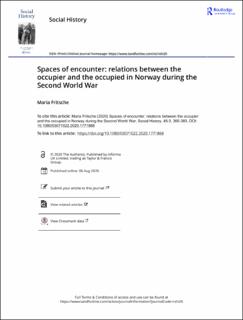| dc.contributor.author | Fritsche, Maria | |
| dc.date.accessioned | 2021-02-10T09:53:34Z | |
| dc.date.available | 2021-02-10T09:53:34Z | |
| dc.date.created | 2020-08-07T11:39:10Z | |
| dc.date.issued | 2020 | |
| dc.identifier.citation | Social history (London). 2020, 45 (3), 360-383. | en_US |
| dc.identifier.issn | 0307-1022 | |
| dc.identifier.uri | https://hdl.handle.net/11250/2727119 | |
| dc.description.abstract | With Nazi Germany’s aggressive expansion, millions of Europeans were forced under German rule. Although the worlds of the occupier and the occupied overlapped in multiple ways, the everyday interactions between members of opposing sides of the conflict have received little scholarly attention. Using German-occupied Norway as a case study, this article explores the manifold relations between German soldiers and civilians during the Second World War. It argues that the asymmetry of power was not stable but constantly shifting as a result of these encounters. Based on an analysis of German military court records, the article identifies crimes and spaces as nodes where these worlds converged. First, using crimes as a lens, it explores how people on both sides responded to the constraints and opportunities the occupation produced. Secondly, it illustrates how space became the real and symbolic battleground in the struggle for power, and how the spatial norms inscribed in public, private and work spaces shaped these interactions. Since concepts of ‘resistance’ and ‘collaboration’ are inadequate to make sense of the complex reality of occupation, the article proposes the categories of conflict, cooperation and solidarity to analyse the diverse social relations between the occupier and the occupied. KEYWORDS: Second World War, German occupation, Norway, social relations, everyday life, space, collaboration and resistance | en_US |
| dc.language.iso | eng | en_US |
| dc.publisher | Informa UK Limited, trading as Taylor & Francis Group. | en_US |
| dc.relation.uri | https://doi.org/10.1080/03071022.2020.1771868 | |
| dc.rights | Attribution-NonCommercial-NoDerivatives 4.0 Internasjonal | * |
| dc.rights.uri | http://creativecommons.org/licenses/by-nc-nd/4.0/deed.no | * |
| dc.title | Spaces of encounter: relations between the occupier and the occupied in Norway during the Second World War | en_US |
| dc.type | Peer reviewed | en_US |
| dc.type | Journal article | en_US |
| dc.description.version | publishedVersion | en_US |
| dc.source.pagenumber | 360-383 | en_US |
| dc.source.volume | 45 | en_US |
| dc.source.journal | Social history (London) | en_US |
| dc.source.issue | 3 | en_US |
| dc.identifier.doi | https://doi.org/10.1080/03071022.2020.1771868 | |
| dc.identifier.cristin | 1822168 | |
| dc.relation.project | Norges forskningsråd: 256369 | en_US |
| dc.description.localcode | This is an Open Access article distributed under the terms of the Creative Commons Attribution-NonCommercial-NoDerivatives License (http://creativecommons.org/licenses/by-nc-nd/4.0/), which permits non-commercial re-use, distribution, and reproduction in any medium, provided the original work is properly cited, and is not altered, transformed, or built upon in any way. | en_US |
| cristin.ispublished | true | |
| cristin.fulltext | original | |
| cristin.qualitycode | 2 | |

